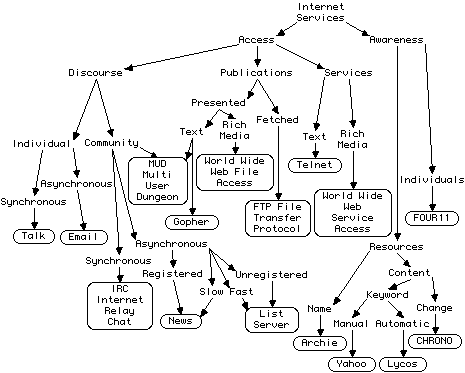
Brian R. Gaines and Lee Li-Jen Chen
Knowledge Science
Institute
University of Calgary
Alberta, Canada T2N 1N4
{gaines,
lchen}@cpsc.ucalgary.ca
The Internet has become a major system for the support of knowledge processes in a wide range of communities, the range of services available has grown, and a variety of tools have been developed to support communities operating through the net. Services and modes of use have evolved rapidly and may give the impression that the net is an anarchical system with little structure. However, there are significant common dimensions underlying all the various services and their use separately and together. This article develops a model for Internet services based on the time structure of punctuated discourse and on the awareness of originators of recipients and vice versa.
The growth of the Internet has provided major new channels for the dissemination of knowledge. Increasing international connectivity has made the net accessible to special-interest communities world wide, and electronic mail and list servers now provide a major communications medium supporting discourse in these communities. Until recent years, limitations on the presentation quality of on-line file formats restricted the publication capabilities of the net to rapid dissemination of files printable in paper form. However, advances in on-line presentation capabilities now allow high-quality typographic documents with embedded figures and hyperlinks to be created, distributed and read on-line. Moreover, it has become possible to issue active documents containing animations, simulations, and supporting user interaction with computer services through the document interface. The major part of this functionality has become accessible through the protocols of the World Wide Web, and the web itself is seen as a precursor to an information highway subsuming all existing communications media.
The development of the net has been very rapid with little central planning, and, despite its widespread use, there is little information as yet on the social dynamics of net technologies. Many systems have been developed cope with the information overload generated by direct access to the net. The wide variety of indexing and search tools now available have in common that they support selective attention and awareness in the communities using the net. It would be useful to be able to analyze the design issues and principles involved in these tools in terms of the knowledge and discourse processes in the communities using these tools.
This article provides a model of the Internet in terms of discourse and awareness and uses it to classify the types of support tools existing and required.
It is tempting to consider the Internet as a new publication medium in which electronic documents emulate paper ones, and where the basic human factors issues are those of indexing and information retrieval. This makes the vast existing literature on information retrieval, its techniques and human factors, relevant to the net. However, this addresses only one aspect of computer-mediated communication, neglecting its function of supporting discourse within communities. Much of the information retrieved from the net is generated as needed through discourse on list servers--the Internet is a mixed community of publications and intelligent human agents that both stores knowledge and generates it on demand. When the information needed cannot be found through retrieval then it may be requested through discourse, a phenomenon prophesied in the early days of timeshared computing:
"No company offering time-shared computer services has yet taken advantage of the communion possible between all users of the machine...If fifty percent of the world's population are connected through terminals, then questions from one location may be answered not by access to an internal data-base but by routing them to users elsewhere--who better to answer a question on abstruse Chinese history than an abstruse Chinese historian." (Gaines, 1971)
The society of distributed intelligent agents that is the Internet community at large provides an `expert system' with a scope and scale well beyond that yet conceivable with computer-based systems alone. Computer-based discovery, indexing and retrieval systems have a major role to play in that community, but are only one aspect of Internet information systems.
Krol (1993) captures the essence of these consideration in Internet RFC1462 which replies to the question "What is the Internet" with three definitions:
These are complementary perspectives on the net in terms of its technological infrastructure, its communities of users, and their access to resources, respectively. Models of computer-mediated communication must taken into account all three perspectives: how agents interface to the network; how discourse occurs within communities; and how resources are discovered and accessed.
Figure 1 is a concept map presenting the major services on the net in terms of a small set of fundamental distinctions:-

Figure 1 Internet services in terms of dimensions of computer-mediated communication
The less well-know systems classified are FOUR11 which provides an index of email addresses, and CHRONO (Chen, 1995) which indexes a web site in reverse chronological order to provide an automatic "what's new" page. MUDs, multi-user dungeons/dimensions, are interesting in providing a mix of services supporting both discourse and resource access. Web browsers such as Netscape are interesting in providing a single tool accessing nearly all the services shown except talk and chat.
Figure 1 presents a conventional model of Internet services in terms of their utility, but it does not provide an integrative model of the way in which they support communities. Such a model can be developed by noting that what distinguishes discourse from publication is that in discourse it is expected that the recipient responds to the originator, whereas publication is generally a one-way communication. However, on list servers some material is published in that the originator expects no specific response, and material published in electronic journals or archives often evokes a response. Computer-mediated communication offers a very flexible medium that breaks down the conventions of other media. The following diagrams show the different characteristics of the main Internet services in terms of these issues.
Figure 2 shows email discourse as a cycle of origination and response between a pair of agents communicating through a computer-mediated channel.
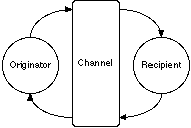
Figure 2 Email discourse
Figure 3 extends Figure 2 to show list server discourse as a cycle of origination and response between agents that is shared with a community through a computer-mediated channel. The community involvement leads to more complex discourse patterns in that: the originator may not direct the message to a particular recipient; there may be multiple responses to a message; and the response from the recipient may itself trigger responses from others who did not originate the discourse. For a particular discourse sequence this leads to a natural division of the community into active participants who respond and passive participants who do not.
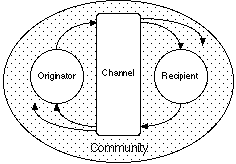
Figure 3 List server discourse
Figure 4 modifies Figure 3 to show web publication as an activity in which the channel is buffered to act as a store also. The material published is available to a community and the originator is unlikely to target it on a particular recipient. Recipients are not expected to respond direct to the originator, but responses may occur through email, list servers or through the publication of material linked to the original. Because the published material is not automatically distributed to a list, recipients have to actively search for and discover the material.
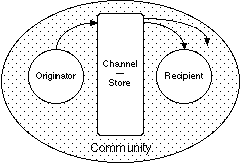
Figure 4 World Wide Web publication
The common structure adopted for the diagrams is intended to draw attention to the commonalities between the services. List server discourse is usually archived and often converted to hypermail on the web. Web publications do trigger responses through other services or through links on the web. A search on the web may not discover a specific item but rather a related item on a newsgroup, list or by an author, and result in an request for information to the newsgroup, list or author. Individuals and communities use many of the available Internet services in an integrated way to support their knowledge processes.
Figure 5 subsumes Figures 2 through 4 to provide an integrated model of Internet knowledge processes that captures all the issues discussed. It models the processes as discourse punctuated by the intervention of a store allowing an indefinite time delay between the emission of a message and its receipt. It introduces two major dimensions of analysis: the times for each step in a discourse cycle; and the awareness by originators of recipients and vice versa.

Figure 5 Punctuated discourse
The four times shown in Figure 5 are:
Note that agent processing times and channel delays have been lumped. A study focusing on the impact of communication delays would want to consider them separately, otherwise there is no significant distinction--a general principle might be that communication delays should not be greater than agent processing times. Note also that the diagram is to a large extent symmetrical--the recipient becomes an originator when responding.
An important overall parameter is the round-trip discourse time, t1+t2+t3+t4. If this is small, a few seconds or less, we talk in terms of synchronous communication. If its is large, a few hours or more, we talk in terms of asynchronous communication. If it is infinite, so that there is no response, we talk in terms of publication. However, this analysis shows that there is a continuous spectrum from synchronous through asynchronous to publication.
The discovery times, t2 and t4, are very significant to publication-mode discourse, and attempts to reduce them have lead to a wide range of awareness-support tools that aid potential recipients to discover relevant material and originators to make material easier to discover.
One can regard a community as a set of agents that provide resources to one other with the most significant dimension relating to the coordination of the community being that of the awareness of who is providing a particular resource and who is using it. In the tightly-coupled team, each person is usually aware of who will provide a particular resource and often of when they will provide it. In logical terms, this can be termed extensional awareness because the specific resource and provider are known, as contrasted to intensional awareness in which only the characteristics of suitable resources or providers are known.
In a special interest community resource providers usually do not have such extensional awareness of the resource users, and, if they do, can be regarded as forming teams operating within the community. Instead, resource providers usually have an intensional awareness of the resource users in terms of their characteristics as types of user within the community. The classification of users into types usually corresponds to social norms within the community, such as the ethical responsibilities in a professional community to communicate certain forms of information to appropriate members of the community. Resource users in a special interest community may have an extensional awareness of particular resources or resource providers, or an intensional awareness of the types of resource provider likely to provide the resources they require. This asymmetry between providers and users characterizes a special interest community and also leads to differentiation of the community in terms of core members of whom many users are extensionally aware, and sub-communities specializing in particular forms of resource.
In the community of Internet users at large, there is little awareness of particular resources or providers and only a general awareness of the rich set of resources is available. Awareness of the characteristics of resources and providers is vague, corresponding to weak intensional awareness.
These distinctions are summarized in Figure 6 and it is clear that the classification of awareness can lead to a richer taxonomy of communities than the 3-way division defined. Analysis of awareness in these terms allows the structure of a community to be specified in operational terms, and in complex communities there will be complex structures of awareness. The coarse divisions into sub-teams and sub-special interest communities provides a way of reducing this complexity in modeling the community.
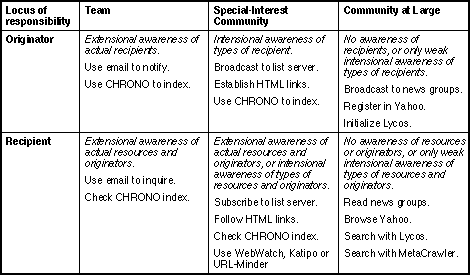
Figure 6 Communities and tools distinguished in terms of awareness
The differentiation of communities in terms of awareness draws attention to the significance of supporting various aspects of awareness in a CMC system. Resource awareness, the awareness that specific resources or resources with specified characteristics exists, may be supported by various indexing and search procedures. However, there is also a need to support chronological awareness, the awareness that a resource has changed or come into existence. Figure 6 also shows the way in which current tools for awareness support are classified within this framework.
The purpose of the research reported in this article has been to develop a finer-grained model of the virtual collaborative processes that occur in Internet communities in order to support and improve those processes through new and better services. The model developed suggests three levels of analysis of services:
CHRONO (Chen, 1995) is a tool resulting from this analysis . We noted that one dimension of awareness management is keeping track of a site where relevant information has been available in the past. CHRONO generates a "what's new" page for a site automatically by indexing the site in reverse chronological order so that a visitor may readily note changes that have occurred since his or her last visit. WebWatch (Specter, 1995), Katipo (Newberry, 1995), and URL-Minder (NetMind, 1995) are other chronological awareness tools that track changes in specified documents.
The key question to ask in developing new awareness support tools is "what is the starting point for the person seeking information, the existing information that is the basis for their search." A support tool is then one that takes that existing information and uses it to present further information that is likely to be relevant. Such information may include relevant concepts, text, existing documents, people, sites, list servers, news groups, and so on. The support system may provide links to further examples of all of these based on content, categorization or linguistic or logical inference. The outcome of the search may be access to a document but it may also be email to a person, a list or a news group. The net is a vehicle for discourse in which the goals of individual agents are supported through social knowledge processes, and support tool design needs to be based on increasingly refined models of those processes. Much of our current research is concerned with the empirical studies of discourse processes on the net through analysis of information diffusion, list server archives, and so on. We conjecture that tools that develop models of such processes and make them available to the participants may themselves result in improved usage of net resources.
Financial assistance for this work has been made available by the Natural Sciences and Engineering Research Council of Canada.
Chen, L.L.-J. (1995). CHRONO: A Chronological Awareness Tool. Knowledge Science Institute, University of Calgary. http://www.cpsc.ucalgary.ca:80/~lchen/cpsc.html#chrono.
Gaines, B.R. (1971). Through a teleprinter darkly. Behavioural Technology 1(2) 15-16.
Krol, E. (1993). FYI on "What is the Internet?". Internet. RFC 1462.
NetMind (1995). The URL-Minder: Your Own Personal Web Robot. NetMind. http://www.netmind.com/URL-minder/URL-minder.html.
Newberry, M. (1995). Katipo--a Web Lurker. Victoria University of Wellington, New Zealand. http://www.vuw.ac.nz/~newbery/Katipo.html.
Specter (1995). WebWatch. Specter Communications. http://www.specter.com/.
Last update: 2002-03-27 by Lee Chen